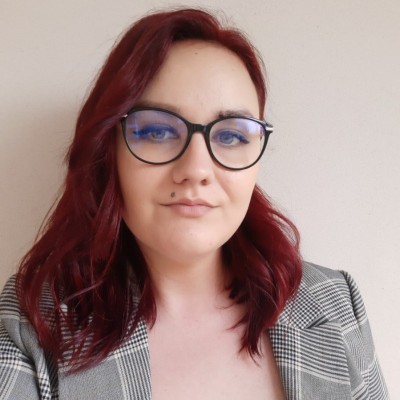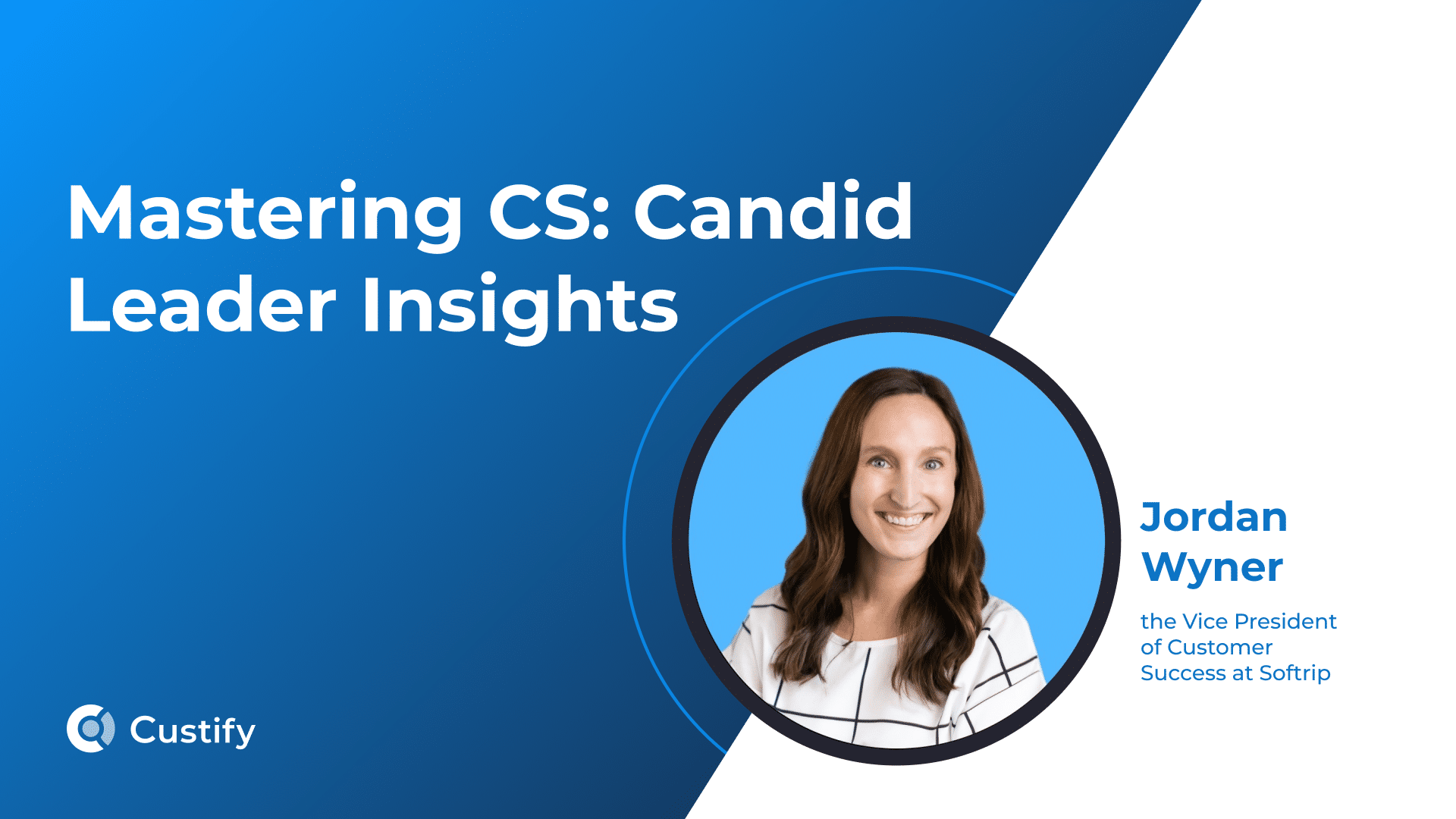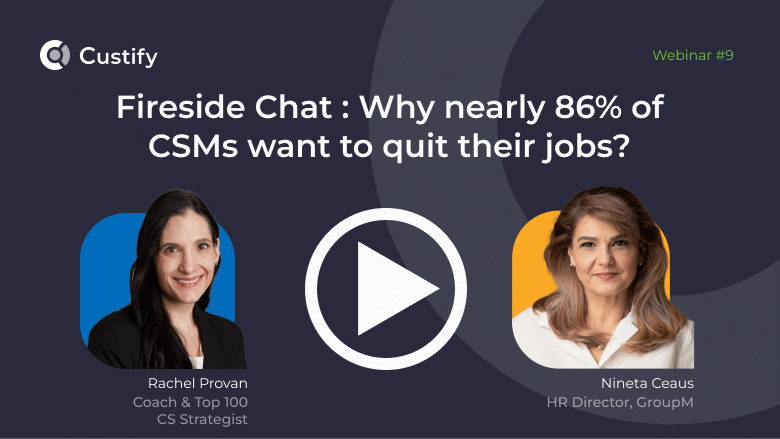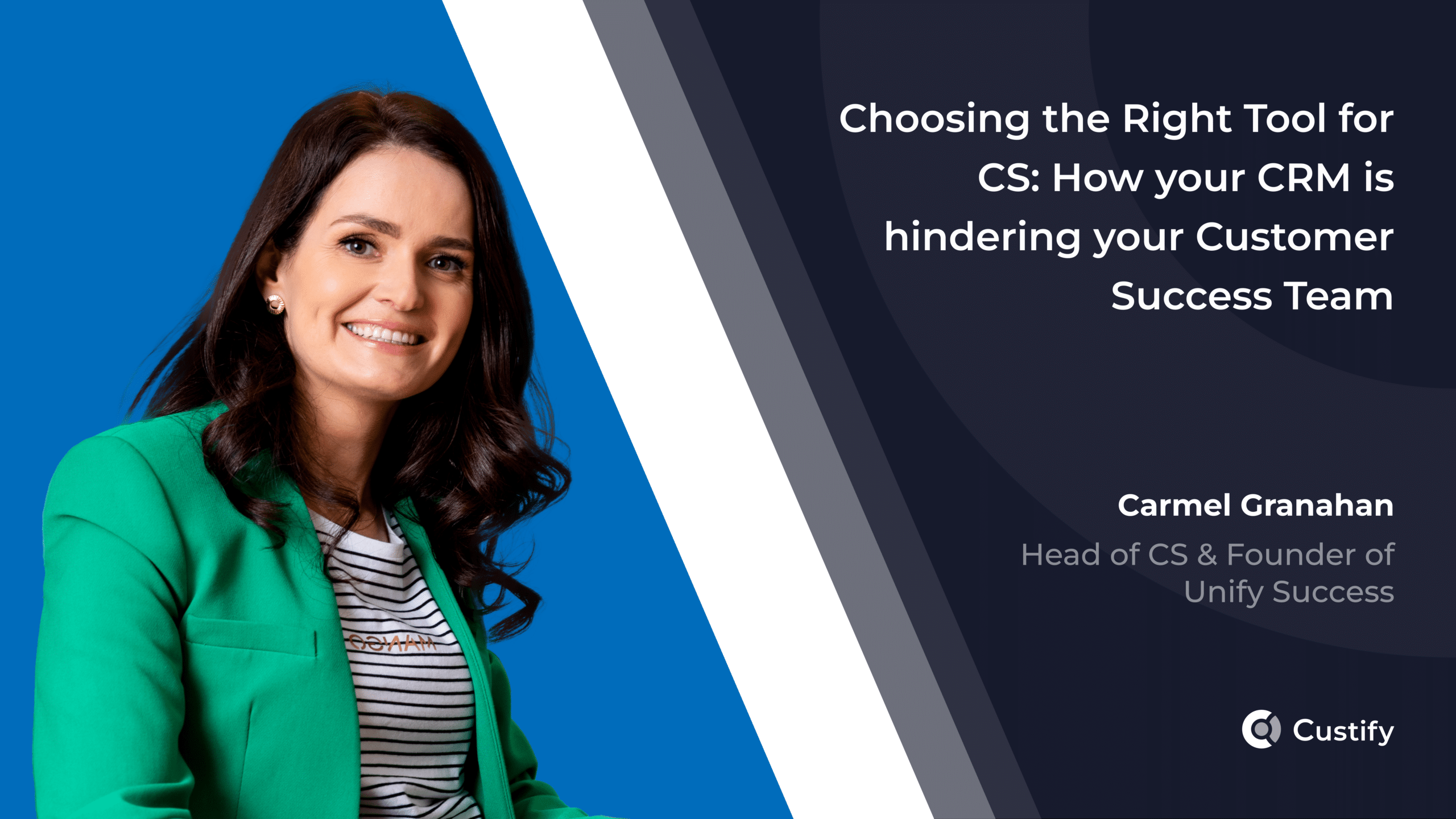In our latest episode of the Mastering CS, Candid Leader Insights podcast, Irina Cismas, Head of Marketing at Custify, discussed with Karina De Alba, Head of Customer Success at Weglot.
Karina talks about her amazing journey from being a dancer instructor in San Francisco to being the Head of CS at a company in Paris.
What You’ll Learn:
- How to switch from one career to another and master various skills
- How to structure the CS customer success team
- What are the right skills for CS
- The importance of the right tool stack for CS
- How to overcome customer challenges
Key insights and takeaways for CSMs based on the interview:
Having a Diverse Career Path: Karina de Alba transitioned through multiple roles—from a dance instructor and paralegal to co-founding a startup and diving into user experience—before becoming Head of Customer Success at Weblock. Her varied background, influenced by her upbringing in San Francisco, fueled her desire for constant learning and growth.
Proactive Customer Success Approach: Karina emphasized the shift from a reactive role in user experience to a more proactive stance in customer success, where she reaches out to customers to ensure they are progressing and offers help before issues arise. This approach reflects her goal of maintaining closer contact with users and improving their experience from the outset.
Building a CS Program from Scratch: As the sole member of Weblock’s Customer Success team, Karina had the opportunity to create the function from the ground up. She focuses on discovery and research, aiming to enhance the onboarding process and establish a solid foundation before expanding the team.
The Importance of Onboarding and Retention: Onboarding is Karina’s primary focus, as it’s the first step in the customer journey. She tracks basic metrics like response rates and customer engagement to prevent churn. Once the onboarding process is optimized, her next priority is ensuring retention by continuing to deliver value to customers.
Podcast transcript
From one career to another
Irina 0:02
Welcome to Mastering CS Candid Leader Insights, the podcast where we deep dive into the world of customer success with industry leaders. I’m your host Irina Cismas and today’s guest is Karina de Alba, Head of Customer Success at Weblock. Karina, welcome and thanks for joining us today.
Karina 0:20
Thank you so much for having me, I’m so excited!
Irina 0:25
Excitement is what I have because you had an interesting career journey from being a dance instructor to working as a paralegal, co-founding a startup, diving into user experience and now for six months leading customer success. I’m curious what inspired you to make all these shifts moving from user experience to customer success.
Karina 0:53
Well, I have to first say it has to do with the fact that I came from San Francisco and in San Francisco we love to do like 10 to 15 things all at once. Like we try to learn and do everything and so I knew that within my personality I can’t do one thing and that’s it. Like I felt even when I first started with dancing, I was doing break dancing for 15 years, I knew that that wasn’t going to be my life and so I was like okay I need to learn how to also be a paralegal and so that way when I’m done being a paralegal I can move on and you know keep growing and growing and growing in my career.
So I have to definitely say it has to do with the fact that I grew up in San Francisco that made me deep dive into all these different careers.
Irina 1:40
And how did you move into Europe?
Karina 1:46
So I actually backpacked. I decided that I wanted to leave everything behind in San Francisco since I grew up there and I started backpacking down from Mexico to Central America to South America, stopped in Chile. That is where I started to do the entrepreneurship.
It was kind of like an incubator. So I wanted to kind of do my own startup there and so that’s where I was learning entrepreneurship. And then I met someone obviously and he was from Europe and I was like why not add that to my resume?
And yeah so I ended up in Paris
Irina 2:27
What are the differences between the US and Europe? What are the pros and cons from a cultural perspective?
Karina 2:36
From a culture perspective Europe is more close to my actual culture because I come from a Mexican culture. It’s more family-oriented, it’s more about being a community. I’m not shaming the U.S. because I love the U.S. and I think they also have very inspirational ideas. They try to do like you know you could do everything in America. So there’s pros and cons on both sides but I think Europe really caught my eye because of the community sense. I just feel like this is more my home so I have to stay here.
Irina 3:08
How has your background in user experience but also founding a company shaped your approach to customer success?
Karina 3:17
I think it’s really taught me the idea of empathy. When you’re behind the scenes you’re being more reactive to what people need. I’m having an issue with your product, can you help me out?
It’s always reactive whereas with customer success it’s now taught me to be more proactive. I’m the one reaching out, I’m the one saying like hey I see that you’re stuck, can I help you out? So I like it more because I’m closer to the user as opposed to before where I was just kind of waiting for them to write me and see how I can help them out that way.
A typical day in the life of a Head of CS
Irina 3:52
Tell us about what you do at Weglot and what does a typical day look like for you as head of customer success now?
Karina 3:59
Well like you mentioned I am the head of customer success. It’s a brand new branch so I am on my own right now. So that means I actually got to build it from scratch which is great because it means there’s no rules and it means that I get to kind of do what I want in a very professional way of course.
And so a typical day is kind of hard to say because it’s never the same day. I try to really focus when I come in on reading all my emails, making sure that all the users that I’ve written to that have written me respond to them, make sure everyone’s taken care of. But I’m also doing a lot of research right now because it is a new role.
I’m trying to educate myself as much as possible in terms of how can I make customer success really impactful within the company. So I would say it’s very discovery right now. Less on the terms of me being like I have all these things set in place.
I’m still it’s a learning process but that’s what makes it so exciting.
Moving from a reactive to a proactive approach
Irina 5:02
I have to ask what was the tipping point when Weglot decided that they need a customer success organization? What was that thing that made them think it’s time to have a CS in place?
Karina 5:20
It actually came from me because I was speaking to the head of sales and we noticed that there is an onboarding process which is great but there was room for enhancement and I was like wait a minute there’s no one really there like taking care of the user. There’s not really someone there like carrying them through their journey and so I thought why not just put myself in that place since I already have the experience. I have a background in cognitive neuroscience which helps me understand how people function, why they do certain actions the way they do, certain personality types and so I thought I fit and so I asked the the co-founders and they’re like yeah you know why not let’s make this a role.
Let’s start from scratch and see where it takes us.
Customer challenges and how to deal with them
Irina 6:08
Let’s speak about the customers you are serving and what kind of challenges do they usually run into and I’ll use this just to set up the scene for my next question.
Karina 6:22
Okay perfect well our customers are pretty broad. We have everything from storefronts, small stores to very big companies. We have entrepreneurs also.
We have agencies so we have a little bit of everything and I think what they usually the issue that they’re or the challenge that they’re running into is definitely having a translation service that is easy to use and the minute that they get started you know it’s all set up. There’s a lot of it and there’s a lot of training that gets involved in a lot of other I think services that people get kind of lost and they don’t really have someone to refer to if they have questions other than the support team. So we’re trying to enhance the onboarding and make sure that as soon as someone signs up whether it’s a you know a starter plan, a beginning one to a big enterprise plan we want to make sure they feel that their hand is held through the process.
The importance of customer onboarding
Irina 7:16
Let’s go deeper on how does it look like and I’m assuming you also worked in the past from your role as user experience into the onboarding. How did you tweak the onboarding process?
Karina 7:34
Well the thing is with onboarding, of since we are self-service, we let the user kind of guide themselves. We don’t put any we’re not like immediately like hey how can we help you? We kind of help them out by giving them the tools that they need and then from there on we say that our support team is one of the best support teams that we have.
We try to help them immediately you know whatever the situation is we’re right there. We answer them within two hours so we’re really proactive but the way that we enhanced it was by being able to catch any kind of help that we can give them beforehand. Before they come to us and say hey I’m stuck.
So my job is to make sure that I can kind of see the the health score see how if they’re you know making the translation. If they’re not really moving in their project I immediately dive in. I’m like hey if you need a call let me know.
I try to make myself as available as possible.
Irina 8:29
Are you at this moment a one-man show? Are you handling all the CS operations on your own?
Karina 8:36
I’m a one-woman show over here. I wish I had a team but not yet. The thing is I didn’t want to set a team in place until I had a concrete base.
I think it’s only fair that we bring people on board once everything is set in place. We have you know all the pillars in place I really keep saying. But for right now I’m a one-woman show.
How to scale the CS ops
Irina 8:58
Well I think your approach is actually fantastic because a lot of the CSMs with whom we are talking they jump and they hurry into implementing stuff or building people bringing people into the team without having some clear processes in place. And also when you are building a team I think it’s very important to understand what do you need? What roles should I bring into a team?
Because every organization has its specifics. So speaking about that how do you after only six months how do you what roles do you have in mind for this? What do you think it will help you scale the CS operations that you have as we speak?
Let’s imagine that how would your CS team look like in the future?
Karina 10:02
I think definitely account managers they’re so precious you know people that can actually stick to a certain clientele like having different account managers for different personas you know different types of backgrounds when it comes to company type. I think ideally that would be something that I would really want to stress because every different persona has a different need. And so you can’t kind of put all the same needs into one company it’s not going to work.
So I would definitely work on having account managers making sure that they specify themselves to each persona. And then after that I think having a really good training program when it comes to communication empathy and product knowledge. Just making sure that they really know what our values are and that way that we all have the same mentality when we come into place and you know we’re all on the same level.
Irina 10:53
Since you are a one-man show and I assume there is a one-to-many approach, I would say at this moment because you are managing the whole portfolio. I assume you rely a lot on automation. Is this true? How does automation work in your case?
Karina 11:28
I’m a little bit more old school when it comes to automation. So I tried not to bring in I think it’s easy when you start this role that you want to a automate and b make sure that you have all these different like technos behind helping you out and you know I’m going to store my customers here. I’m going to keep the conversations here.
I’m gonna you know do a b and c over here. I don’t want to do that because I’m going to get too confused. It’s too much for me.
So I like to just centralize it and keep it maybe on three technos maximum and that way I’m still hands-on. I still write users. I still use my gmail.
I want people to still feel like it’s got a personal touch to it as opposed to being automated.
Irina 12:12
Okay but do you think it’s realistic? How can you scale it? How does the scaling plan look like at this at this stage?
Karina 12:22
At this stage it’s realistic because the customer base is still pretty low for me like I don’t have a lot of people getting back to me just yet. I don’t have hundreds of people so it’s really realistic but I can admit that at a certain point maybe in a couple months it’s not going to be realistic anymore like I’m not going to be able to answer 200 to 300 emails a day. So then we have to think about you know automating a little bit more and so that’s something more in the future.
Sales and CS collaboration
Irina 12:50
You mentioned that you initially had the interaction where you had that your this role started from us for interaction with the person who is handling the sales operation. How is the collaboration between the sales and you in this moment?
Karina 13:13
It’s actually great. I have a great collaboration with the sales team. The best thing about this role is that I’m kind of cross-collaborating everywhere with the data team also.
It’s amazing because it’s like I said it’s never the same day. It’s one day I have a project with the data team the next day I have another project with the sales team. So in terms of how our communication is and how our workflows are it’s a really positive experience and I have to also say that it enriches my my role because it’s not just me.
I don’t feel like I’m working alone. I honestly feel I have a team. It’s everyone helping me out.
Proving the value of CS to Leadership
Irina 13:53
You are very lucky because one of the challenges that I hear from a lot of CSM or a head of CS is the fact that they are struggling to prove the value of the CS. They don’t have the leadership buy-in. So I want to ask you how did you navigate those initial conversations and how do you prove the value of what you do in front of your peers but also in front of the CEO and other leadership team members?
Karina 14:42
When I was doing the user experience part I was actually directing the support team. It was me and my co-head Chris at the time. We were both directing them so I was really engaged in dealing with all the support and putting in all the processes and what we decided to do was periodically we would have everyone from the office help out in terms of doing support tickets so that they can see how we help users see what kind of problems they’re having.
So then on it branched off to us explaining we need a customer success in order for them to have a pre-onboarding to make them feel that they’re already valued from the beginning instead of them being just valued when they have a problem. So everyone from the office was able to see that not only do we we need support because obviously when people have questions but customer success is also really important because there needs to be someone there to help them out from the beginning. Like if you buy something you buy a product you want to kind of know how to use it you want to navigate through it you want to feel comfortable knowing that there’s someone there that’s going to help you and so bringing that value and showing it to everyone in the office it made it really easy for them to accept it and say okay yeah we really need this.
And also when we when we talk about the products sometimes there’s some people that weren’t aware of certain features and so you know I told them if there was a customer success person then I would have been able to show you that and so I’m pretty lucky to say that everyone sees the value in this role.
Starting a new role in CS and finding the North Star metrics
Irina 16:20
Because you have a fresh new role and you transitioned I’m curious what did you do in your first six months? How did you approach this role? What were the first things when you said okay starting with today I’m head of customer success okay I’m like a CEO at my own company I do have a mini company inside a bigger company so I set up the role. How did you approach it?
Karina 16:53
I have to say that I was given by a lot of fear. I was completely scared I was like okay what did I just get myself into I was completely great in my role my previous role but the problem was that I was too settled in and I felt like I needed something exciting.
I used that fear. I switched it to excitement and was like okay what do we need to get started and the first thing I did I got myself a mentor someone who kind of had more experience in the CSM world.
She guided me through she said okay let’s start basic we’re not going to go crazy and start implementing a million things which is great because I didn’t want to do that and the first thing that we started on was onboarding which is what is still my biggest focus right now.
Because it’s the first step from everything and so right now that’s that’s kind of where I’ve been at I’ve been doing a lot of research been with my mentor and really making sure that the onboarding process is really straightforward.
Irina 17:54
Speaking the onboarding process and starting from starting from scratch what were the data points that were important for you? What data are you collecting or reporting? What are your north star metrics in order to make sure that what you are building in the right way?
Karina 18:14
Right now, the metrics I’m tracking are fairly basic, primarily focusing on response rates—whether people are engaging with my messages. We’re experimenting with different approaches, such as reaching out immediately when a user signs up. For instance, if a user signs up but doesn’t have a project on their account, I reach out to offer assistance and guide them. At this stage, the metrics are simple, and I’m not yet focusing on major KPIs. However, the key areas I’m monitoring closely are onboarding, churn prevention, and retention.
Irina 18:53
Okay, what comes next after onboarding on your agenda? After you solve the onboarding issue what will your next big projects be?
Karina 19:08
Moving on to retention because once they’re onboarded and they’re great we got to make sure they stay on board and we got to make sure that they’re happy with the product that they see the value and we got and that way they’ll be able to stay with us further
Irina 19:22
Since you have a technical background, I’d like to ask your perspective on the role of technology in scaling customer success operations, particularly the role of AI. Do you see it as important or not? While you mentioned that you’re not currently using AI in your CS processes, are you against it, or is it just not the right time yet?
Karina 20:11
AI is something amazing, and it’s something that we should incorporate into our role. It’s kind of silly to fight it because it has taken over so much, and I think it’s important that it becomes part of what we do. But right now, I’m not really using it when dealing with users. I’m relying more on my own human skills—my empathy skills, my soft skills, basically. Long-term, of course, AI is already part of Weblock, which is great, and it has already been integrated. But as for integrating it into customer success itself, I haven’t planned that out yet, though I think it will happen eventually.
Irina 20:25
I actually realized that I still have one more question for you because I realized that you basically started in this CS environment six months ago what would be your advice for everyone who is considering to step into this into this domain of customer success?
Karina 20:52
I think that’s a great question. Don’t be afraid. I think fear is something that’s a great way to drive yourself to do something every day will be different um you get to use all your different skills I mean you know you saw my background and I get to use all my different skills in different situations different scenarios so if you’re just getting started it’s going to be okay make sure you do a lot of research but really try to make it make it your own don’t try to copy someone else because I don’t try to do that anymore I’m just like let me make it my own use my own skills.
Irina 21:15
Thank you so much Karina for sharing your insights with us today and a big thank you to all our listeners until next time stay safe and keep mastering customer success.




